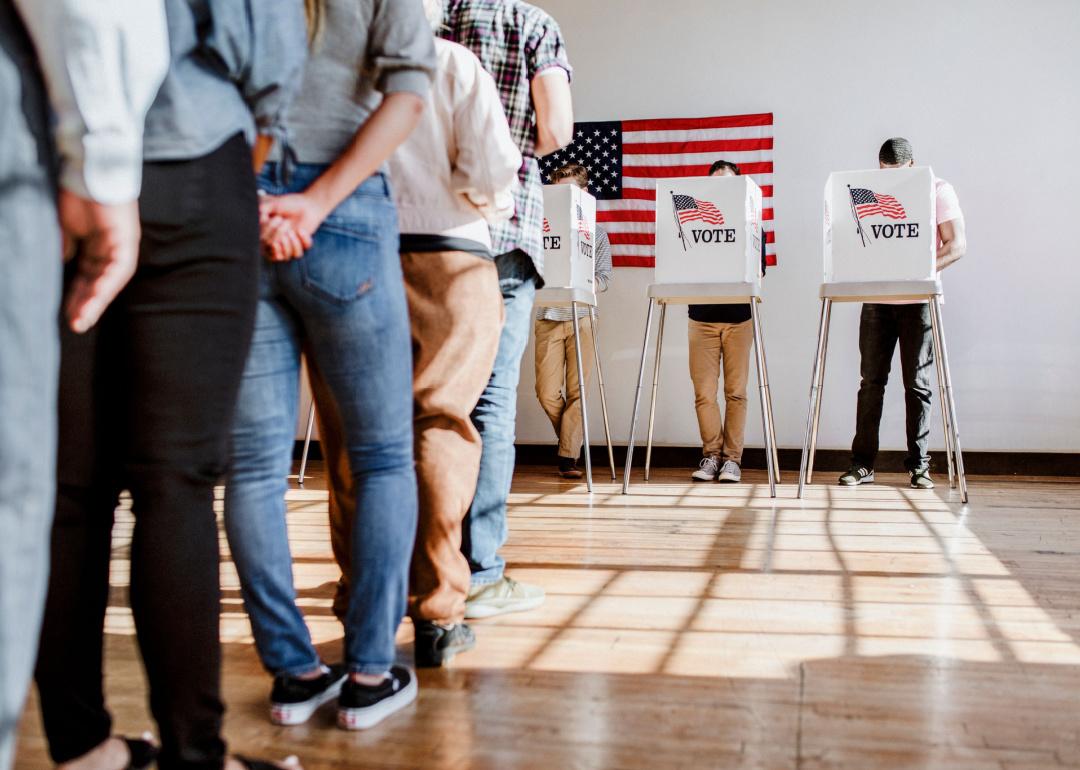
2.2 million votes: See the demographics of Mississippi's voting population
2.2 million votes: See the demographics of Mississippi's voting population
In 2020, 158.4 million citizens—almost two-thirds of estimated eligible voters—voted in the presidential elections, according to the Pew Research Center. The number represented a higher than average turnout, with people voting in numbers not seen since 1980 and possibly well before.
Stacker compiled voter demographics for each state and Washington, D.C., using the 2019 U.S. Census Bureau's American Community Survey (released in September 2020). Each slide shows the state's voting-eligible population (citizens who are 18 or older) and the breakdown of that population by sex, age, race, and education. Economic statistics are not included because the American Community Survey does not account for COVID-19, which affected unemployment, poverty, and medical insurance status for millions of Americans. In order to avoid making any assumptions about the data or the participants of the American Community Survey, Stacker used the exact wording of the "race" and "sex" framework that was provided in the census data.
Keep reading to see the voter demographics of your state.
Mississippi by the numbers
- Voting-eligible population: 2,246,323
- Breakdown by sex: 47.5% male, 52.5% female
- Breakdown by age: 21.4% 18-29 years old, 24.2% 30-44 years old, 32.8% 45-64 years old, 21.6% 65+ years old
- Breakdown by race: 60.3% White, 37.1% Black or African American, 0.7% Asian, 1.9% Hispanic or Latino, 0.0% Native American or Alaska Native, 0.0% Native Hawaiian or Pacific Islander, 0.9% two or more races
- Breakdown by education: 3.9% less than high school education, 10.5% some high school (no diploma), 30.1% high school graduate or equivalency, 25.0% some college (no degree), 10.2% associate's degree, 12.7% bachelor's degree, 7.5% graduate or professional degree
Mississippi represents one of the closest gaps between its white and Black or African American voters. While still at a 23.2% difference, it is much lower than in predominantly white states like Maine, where the gap stretches to 94.7%. There are reportedly more than 1 million African Americans who reside in Mississippi, contributing to the high voting populace.
By percentage, voters aged 45–64 are the highest in every state, with registered voters over the age of 45 comprising more than half the country's population. Older voters also trend toward turning out to vote at a higher rate and played a significant role in former President Donald Trump's 2016 victory in Florida.
Along racial lines, Black or African American voters in Louisiana and Georgia comprise more than 30% of the state's registered voters. California and Texas—which award the most electoral votes at 55 and 38, respectively—boast the highest numbers of Latino voters. On the other end of the spectrum, West Virginia and Maine boast the highest percentage of white voters. A number of states had already seen record voter turnouts, with 16 seeing more than half of its registered voters casting a ballot before Election Day.
Continue reading for a glimpse into the voter demographics of neighboring states.
Alabama
- Voting-eligible population: 3,731,336
- Breakdown by sex: 47.4% male, 52.6% female
- Breakdown by age: 20.5% 18-29 years old, 23.5% 30-44 years old, 33.3% 45-64 years old, 22.8% 65+ years old
- Breakdown by race: 69.9% White, 26.7% Black or African American, 0.9% Asian, 2.2% Hispanic or Latino, 0.0% Native American or Alaska Native, 0.0% Native Hawaiian or Pacific Islander, 1.3% two or more races
- Breakdown by education: 3.1% less than high school education, 9.2% some high school (no diploma), 31.6% high school graduate or equivalency, 23.5% some college (no degree), 8.6% associate's degree, 15.2% bachelor's degree, 8.9% graduate or professional degree
Based on the 2018 gubernatorial race in Alabama, counties with a higher number of minorities favored the Democratic ticket, while voters 40 and older preferred the GOP ballot. Education level reportedly has nothing to do with how Alabamians voted in the election three years ago.
Arkansas
- Voting-eligible population: 2,235,415
- Breakdown by sex: 48.1% male, 51.9% female
- Breakdown by age: 20.7% 18-29 years old, 23.6% 30-44 years old, 32.4% 45-64 years old, 23.3% 65+ years old
- Breakdown by race: 79.7% White, 15.5% Black or African American, 1.1% Asian, 3.9% Hispanic or Latino, 0.0% Native American or Alaska Native, 0.1% Native Hawaiian or Pacific Islander, 1.8% two or more races
- Breakdown by education: 3.4% less than high school education, 7.9% some high school (no diploma), 35.1% high school graduate or equivalency, 24.5% some college (no degree), 7.4% associate's degree, 14.5% bachelor's degree, 7.3% graduate or professional degree
Arkansas voters are standing in line for longer than ever before to cast their ballot, with some counties seeing record turnouts, compared to the 2012 and 2016 presidential elections. Pulaski, the state's most massive county populace of more than 391,000 with over 250,000 registered voters, tripled the number of absentee ballot requests for the 2020 election compared to 2016.



